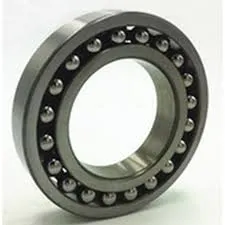
Nov . 08, 2024 13:03 Back to list
Ball Bearing Production Equipment for Efficient Manufacturing Processes and Improved Quality
The Evolution of Ball Bearing Manufacturing Machines
Ball bearings are essential components in a wide range of mechanical systems, facilitating smooth and efficient operation by reducing friction between moving parts. As industries evolve and demand for precision and performance increases, the machinery used for producing ball bearings has also undergone significant transformations. This article explores the technological advancements in ball bearing manufacturing machines, their importance in the industry, and future trends.
Understanding Ball Bearings
Ball bearings are typically composed of an inner and outer race, along with balls that sit between the two races. This simple yet effective design allows the bearing to support loads while minimizing friction—a critical feature in applications ranging from automotive parts to aerospace machinery. High-performance bearings are vital for ensuring reliability, enhancing performance, and extending the life of mechanical systems, thus making their manufacturing process crucial.
Traditional Manufacturing Processes
Traditionally, the manufacturing of ball bearings involved several steps, including forging, heat treatment, machining, and grinding. Each step was primarily labor-intensive, and the precision of the final product depended heavily on the skill of the operators. Early machines were simple, often employing manual controls that required substantial operator expertise.
For instance, the machining process for the bearing races involved lathes and milling machines, which were limited in their ability to achieve the precise tolerances required. Grinding was equally labor-intensive and relied on operators to monitor the process closely to avoid defects. While these traditional methods served their purpose, they were not capable of meeting the increasing demands for higher efficiency and precision.
The Rise of Advanced Manufacturing Machines
With the advent of automation and computer-controlled technologies in the late 20th century, the manufacturing of ball bearings began a significant shift. Advanced CNC (Computer Numerical Control) machines emerged, allowing for greater accuracy and consistency in machining operations. These machines could be programmed to execute complex patterns with impeccable precision, significantly reducing the time and labor required for production.
ball bearing manufacturing machine

Moreover, the introduction of robotic systems into the manufacturing line further streamlined the process. Robots could handle repetitive tasks, such as loading and unloading materials, which improved safety and freed human operators to focus on oversight and quality control. This automation resulted in increased production rates and enhanced product quality, meeting the growing demands of various industries.
Innovations in Machining Techniques
One of the most transformative innovations in ball bearing manufacturing has been the development of hybrid manufacturing techniques. These methods combine additive manufacturing, or 3D printing, with traditional machining processes. 3D printing enables the creation of complex geometries and components that were previously difficult or impossible to achieve through conventional means. When combined with CNC machining, manufacturers can produce lightweight, high-strength bearings that meet stringent performance criteria.
Additionally, advancements in materials science have led to the development of new materials that enhance the performance and durability of ball bearings. For example, ceramics and composite materials offer superior resistance to wear, corrosion, and thermal expansion, making them ideal for high-performance applications such as aerospace and high-speed machinery.
Future Trends in Ball Bearing Manufacturing
As we look to the future, several trends are expected to shape the landscape of ball bearing manufacturing. Industry 4.0 technologies, including the Internet of Things (IoT), artificial intelligence (AI), and big data analytics, are set to revolutionize how manufacturers operate. These technologies provide real-time data on machine performance, enabling predictive maintenance and reducing downtime.
Furthermore, sustainability is becoming a focal point in manufacturing processes. More companies are seeking to adopt eco-friendly practices, which include reducing waste, optimizing energy consumption, and utilizing recyclable materials in production. This shift not only aligns with global sustainability goals but also aids in reducing operational costs.
Conclusion
The evolution of ball bearing manufacturing machines reflects broader trends in technological advancement and industrial growth. From traditional methods to modern automated systems, the journey has been marked by continuous improvements in efficiency, precision, and materials. As industries continue to demand higher performance and sustainability, it is clear that the future of ball bearing manufacturing will be shaped by innovative technologies and practices that prioritize both efficiency and environmental responsibility.
Latest news
-
Grooved Ball Bearing Design and Functionality
NewsJun.04,2025
-
Concrete Mixer Bearing Load Capacity Testing
NewsJun.04,2025
-
6004 Bearing Dimensions in Robotic Joint Designs
NewsJun.04,2025
-
Advantages of Single-Row Deep Groove Ball Bearings
NewsJun.04,2025
-
Applications of Deep Groove Ball Bearings in Automotive Systems
NewsJun.04,2025
-
Innovations in Bearing Pressing Machine Design
NewsJun.04,2025
